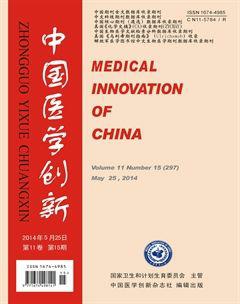他汀类药物预防心肌梗死后房颤发生的临床研究*
周志堂
他汀类药物预防心肌梗死后房颤发生的临床研究*
周志堂①
目的:探讨他汀类药物对心肌梗死后房颤的预防作用。方法:选取2012年1月-2013年12月本院收治的80例急性心梗患者,根据随机数字表法将其分为他汀组和非他汀组各40例。他汀组入院前已规律服用他汀类药物,非他汀组入院前未服用过他汀类药物,对两组患者进行心电监测,观察心梗后房颤的发生率及阵发性房颤再发生率。结果:他汀组的房颤发生率10.0%明显低于非他汀组的22.5%,且阵发性房颤再发生率33.3%明显低于非他汀组的66.67%,差异均有统计学意义(P<0.05)。结论:他汀类药物能有效降低MI后房颤的发生率,且有利于预防阵发性房颤的再发生,有效预防阵发性房颤发展为永久性房颤。
他汀类药物; 心肌梗死; 房颤
心肌梗死(myocardial infarction,MI)是一种常见的威胁患者生命的紧急的、严重的心血管疾病[1]。心肌梗死后患者可出现多种并发症,90%以上的心肌梗死患者并发心律失常[2]。其中,房颤(atrial fibrillation,AF)是心肌梗死后最为常见的心律失常之一。房颤发生时,心房有效收缩功能丧失,心室率不规则,血液流动异常,导致原有病情加重。因此,心肌梗死患者房颤的预防尤为重要。近年来的研究发现,他汀类药物对AF发生有一定预防作用[3-4],但鲜见他汀类药物对预防心肌梗死患者并发房颤的报道。本文对他汀类药物预防心肌梗死后房颤发生的疗效进行研究,现报告如下。
1 资料与方法
1.1 一般资料 选取2012年1月-2013年12月本院心内科住院确诊的80例MI患者。MI诊断标准符合国际心脏病学会和协会(ISFC)及WHO临床诊断标准:(1)典型或不典型病史;(2)肯定性心电图改变;(3)血清心肌酶浓度的序列变化。按照随机数字表将所有患者分为他汀类药物治疗组和非他汀类药物治疗组各40例。他汀类药物组40例患者中,男21例,女19例,平均年龄(63.2±1.1)岁,入院前已规律服用他汀类药物;非他汀类药物组40例患者中,男27例,女13例,平均年龄(61.7±1.2)岁,入院前未服用过他汀类药物。两组患者的性别、年龄等一般资料比较差异无统计学意义(P>0.05),具有可比性。
1.2 入选标准
1.2.1 AF的入选标准 (1)发病前无房颤史;(2)在心肌梗死发病后连续心电监护3~7 d出现房颤;(3)排除甲状腺功能亢进、瓣膜病、肝肾功能障碍等疾病。
1.2.2 阵发性房颤的入选标准 房颤分为阵发性房颤、持续性房颤与永久性房颤。阵发性房颤的入选标准:房颤发作并自行终止,持续时间小于2 d。
1.3 方法 应用的他汀类药物包括:阿托法他汀、辛伐他汀、普伐他汀、洛伐他汀。各种他汀的剂量为:阿托法他汀10~20 mg/d、辛伐他汀20~40 mg/d、普伐他汀20~40 mg/d、洛伐他汀40~80 mg/d。患者通过心电监护仪或床边心电图确认房颤心律。住院期间均行心电监测,以住院期间发生房颤为房颤发生的观察终点。随访半年,观察两组患者AF再发生率。
1.4 统计学处理 采用SPSS 17.0软件对所得数据进行统计分析,计数资料采用 字2检验,以P<0.05为差异有统计学意义。
2 结果
2.1 两组MI后房颤发生率的比较 80例MI患者住院期间发生AF的总病例数为13例,发生率为16.3%。他汀组心梗后有4例房颤者,房颤发生率为10.0%。非他汀组心梗后有9例房颤者,房颤发生率为22.5%,他汀组的房颤发生率明显低于非他汀组,差异有统计学意义(P<0.05)。
2.2 两组阵发性房颤再发生率的比较 13例房颤患者中,阵发性房颤9例。其中他汀组阵发性房颤3例,阵发性发颤再次发作1例,再发率为33.3%。非他汀组阵发性房颤6例,阵发性发颤再次发作4例,再发率为66.7%,他汀组阵发性房颤再发生率明显低于非他汀组,差异有统计学意义(P<0.05)。
3 讨论
临床上,房颤是MI后最为常见的并发症[5-6]。当MI发生后,由于心肌收缩力减弱与心房压升高,容易造成其缺血坏死[7-8]。并且产生的炎症会导致心肌细胞凋亡、心肌坏死等现象的发生,从而造成心房组织与结构的重构,成为AF发生与复发的首要原因[9]。根据国内外文献报道,AF的发生率为6%~20%。本研究显示,本院住院MI患者AF发生率为16.3%,与国内外报道一致[10]。
房颤发生易导致血液动力学障碍,被认为是MI预后差的表现[11]。心肌梗死并发房颤可能的机制为,冠状动脉供血障碍影响窦房结动脉,房室结动脉供血,导致窦房结功能减退,进而使心房肌缺血,电稳性降低,右心室梗死。右心房因负荷过重而扩大,造成右心房梗死。当心肌梗死范围较大,心房肌负担过重时,易诱发房颤。同时,房颤增快心室率,加重心肌缺血,导致梗死面积进一步扩大,继而加重病情。
目前,已有临床研究和Meta分析认为,他汀类药物对预防房颤发生及降低房颤再发生有较好疗效[12]。文献[13]中报道,他汀能够在短期内迅速抑制体内高炎症状态,并显著抑制由炎症导致的心房电生理改变,在一定程度上减轻由于心房快速搏动而引起的心房电重构,降低AF的诱发率与持续时间。本研究证实,他汀类药物能有效降低MI后房颤的发生率,且他汀类药物有利于预防阵发性发颤的复发,有效防止房颤发展为阵发性或永久性发颤。他汀类药物预防AF的机制尚不明确,可能与他汀增加血管内皮源NO合成酶及抑制HMG-CoA还原酶活性,从而改善血管内皮和心肌收缩功能有关。
他汀类药物(statins)是羟甲基戊二酰辅酶A(HMG-CoA)还原酶抑制剂,此类药物通过竞争性抑制内源性胆固醇合成限速酶(HMG-CoA)还原酶,阻断细胞内甲羟戊酸代谢途径,使细胞内胆固醇合成减少,从而反馈性刺激细胞膜表面(主要为肝细胞)低密度脂蛋白(low density lipoprotein,LDL)受体数量和活性增加、使血清胆固醇清除增加、水平降低[14]。他汀类药物还可抑制肝脏合成载脂蛋白B-100,从而减少富含甘油三酯AV、脂蛋白的合成和分泌[15]。
综上所述,他汀类药物治疗具有降低MI后房颤发生和再发生的作用。但目前尚无大样本、随机双盲研究,循证医学证据还不充分,其预防疗效有待于进一步的研究。
[1] Angeli F,Reboldi G,Garofoli M,et al.Atrial fibrillation and mortality in patients with acute myocardial infarction:a systematic overview and meta-analysis[J].Current Cardiology Reports,2012,14(5):601-610.
[2] Deo R,Varosy P D.Invited commentary—global arrhythmia burden:the public health implications of the rise in atrial fibrillation comment on “the increasing burden of atrial fibrillation compared with heart failure and myocardial infarction”[J].Archives of Internal Medicine,2012,172(9):741-742.
[3] Jabre P,Jouven X,Adnet F,et al.Atrial fibrillation and death after myocardial infarction a community study[J].Circulation,2011,123(19):2094-2100.
[4] Jabre P,Roger V L,Murad M H,et al.Mortality associated with atrial fibrillation in patients with myocardial infarction clinical perspective:a systematic review and meta-analysis[J].Circulation,2011,123(15):1587-1593.
[5] Lamberts M,Olesen J B,Ruwald M H,et al.Bleeding after initiation of multiple antithrombotic drugs,including triple therapy,in atrial fibrillation patients following myocardial infarction and coronary intervention:a nationwide cohort study[J].Circulation,2012,126(10):1185-1193.
[6] Lin C J,Liu C F,Kung C T,et al.The prognostic value of atrial fibrillation on 30-day clinical outcome in patients with ST-segment elevation myocardial infarction undergoing primary percutaneous coronary intervention[J].International Heart Journal,2010,52(3):153-158.
[7] Lopes R D,Li L,Granger C B,et al.Discharge warfarin is underused in high risk atrial fibrillation patients with myocardial infarction[J].Circulation,2010,122(21):43-51.
[8] Lopes R D,Li L,Granger C B,et al.Atrial fibrillation and acute myocardial infarction:antithrombotic therapy and outcomes[J]. The American Journal of Medicine,2012,125(9):897-905.
[9] Patanè S,Marte F.Atrial fibrillation and acute myocardial infarction without significant coronary stenoses associated with subclinical hyperthyroidism and erythrocytosis[J].International Journal of Cardiology,2010,145(1):e36-e39.
[10] Wong C X,Brooks A G,Leong D P,et al.The increasing burden of atrial fibrillation compared with heart failure and myocardial infarction:a 15-year study of all hospitalizations in Australia[J].Archives of Internal Medicine,2012,172(9):739-741.
[11]朱永彪,张莹,陈心涛.他汀类药物对急性心肌梗死后再灌注心律失常的影响[J].中国医学创新,2011,8(27):29-30.
[12]王丽.他汀类药物治疗42例不稳定型心绞痛的临床观察[J].中外医学研究,2013,11(11):22-23.
[13]杨帆,丁伯平.他汀类药物的应用进展及存在问题[J].中外医学研究,2012,10(4):162-164.
[14]李学军,李凤.辛伐他汀治疗急性冠脉综合征患者的临床研究[J].中国医学创新,2011,8(3):97-98.
[15]赵水平.他汀类药物防治冠心病的临床应用[J].中华心血管病杂志,2004,31(4):316-318.
The People’s Hospital of Shixing County,Shixing 512500,China
Clinical Studies of Statins to Prevent Atrial Fibrillation after Myocardial Infarction
ZHOU Zhi-tang.
Objective:To investigate the preventive effect of statins on atrial fibrillation after myocardial infarction.Method:80 patients with acute myocardial infarction from January 2012 to December 2013 in our hospital were selected,they were randomly divided into the statin group and the non-statin group according to the random number table method,40 cases in each group.The statin group was given statins regularly before admission,the non-statin group wasn’t given statins before admission.The two groups underwent ECG monitoring,and the incidence of atrial fibrillation after myocardial infarction and the recurrent rate of paroxysmal atrial fibrillation of the two groups were observed and compared.Result:The incidence of atrial fibrillation of the statin group was 10.0%,it was significantly lower than 22.5% of the non-statin group,and the recurrence rate of paroxysmal atrial fibrillation of the statin group was 33.3%,it was significantly lower than 66.7% of the non-statin group,the differences were statistically significant(P<0.05).Conclusion:Statins can reduce the incidence of atrial fibrillation after MI,and conducive to the prevention of paroxysmal atrial fibrillation recur.It can effectively prevent the paroxysmal atrial fibrillation become permanent atrial fibrillation.
Statins; Myocardial infarction; Atrial fibrillation
Medical Innovation of China,2014,11(15):081-083
韶关市医学科研课题项目(WSTJJ2012111544022219710 5060038)
①广东省韶关市始兴县人民医院 广东 始兴 512500
周志堂
10.3969/j.issn.1674-4985.2014.15.029
2014-03-20) (本文编辑:欧丽)

